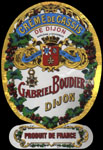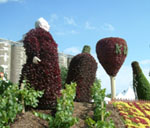![]()
Recent Articles

Get
all the evaluations for
the August
Release
Subscribe
to Vintage Assessments today
by Clicking
Here
This
not-for-profit website is dedicated to the discerning reader!
The
Berry Essence
From blackcurrant to cherry
© Michael Vaughan 2003
National Post Weekly Wine & Spirits Columnist
Saturday, August 9, 2003
Launch
of winefind.ca
The system is foolproof and easy. If there is a wine that interests you, just
click on the name and you will instantaneously connected with the LCBO
database telling you if the wine is in the LCBO system. If it is, it
will appear in blue and
all you have to do is click on the
name again and then the next screen will provide details on the wine
along with a store search. While the number of bottles in each store is
updated every night, you should call the store first to see if stock still
remains (each store phone number is also provided). It is that simple!
Note that all the items recommended below are connected with the LCBO
database – just click on the name!
In a universe before
the advent of synthetic flavour enhancing chemicals, one of the great
treasures was the purity of fruit that could be attained through
macerating perfectly ripe cassis or blackcurrants in alcohol to which
sugar was added.
Although
blackcurrants had been cultivated in France since the 16th century,
primarily for their medicinal properties, it wasn’t until the early
1800s that the idea of making them into a liqueur evolved in the Dijon
region of France. It was here in the home of Burgundy that Crème de
Cassis De Dijon became an enormous success - a highly sought-after elixir
among Europe’s rich and famous. A success based on the unique quality of
locally grown fruit that remains unsurpassed to this day. This, in turn,
created a "Cassis rush" - a virtual explosion in the cultivation
of blackcurrants.
 All
of this leads me to my August Vintages release highlight - Gabriel
Boudier Crème de Cassis de Dijon (974444) at
$29.95, which comes in a traditional 500 ml bottle square-shaped
bottle. The colour is a deep intense purple tinged royal red. The nose is
very concentrated with sweet, spicy, fresh ripe blackcurrant essence.
Ditto on the palate, which is very dense, rich and sweet, but at the same
time well balanced and exceedingly delicious. Only 844 bottles are
available (so see where click
here).
All
of this leads me to my August Vintages release highlight - Gabriel
Boudier Crème de Cassis de Dijon (974444) at
$29.95, which comes in a traditional 500 ml bottle square-shaped
bottle. The colour is a deep intense purple tinged royal red. The nose is
very concentrated with sweet, spicy, fresh ripe blackcurrant essence.
Ditto on the palate, which is very dense, rich and sweet, but at the same
time well balanced and exceedingly delicious. Only 844 bottles are
available (so see where click
here).
Unfortunately, Crème
de Cassis De Dijon is a bit of a harder sell today. After all, how many
folks are drinking sweet liqueurs on the rocks? Add to this the fact that
there’s nobody alive to remember Gabriel Boudier who founded a company
in 129 years ago. Nor does this producer have the deep pockets to launch
advertising campaigns to popularize this unique liqueur.
 Fortunately,
there is an extremely popular summer drink known as Kir (rhymes with hear), a libation which happened to be the favourite
drink of the beloved major of Dijon from 1945 to 1965 whose name was Canon
Felix Kir. Renown for his
resistance work during World War II, he would love to drink a frosty “Vin
Blanc Cassis” which was
traditionally 1 part Crème de Cassis de Dijon with 4 parts of dry white
wine, usually a well chilled Bourgogne Aligoté or Macon. After his death,
the drink was renamed in his honour and is the second most popular apéritif
in France.
Fortunately,
there is an extremely popular summer drink known as Kir (rhymes with hear), a libation which happened to be the favourite
drink of the beloved major of Dijon from 1945 to 1965 whose name was Canon
Felix Kir. Renown for his
resistance work during World War II, he would love to drink a frosty “Vin
Blanc Cassis” which was
traditionally 1 part Crème de Cassis de Dijon with 4 parts of dry white
wine, usually a well chilled Bourgogne Aligoté or Macon. After his death,
the drink was renamed in his honour and is the second most popular apéritif
in France.
Today, Jean, François
and Yves Battault (the three sons of Pierre Battault, the nephew of Marcel
Battault who acquired the firm in 1936) now jointly run the family firm.
To this day, only two blackcurrant varieties known as "noble
varieties" are selected for their richness in flavour and aroma are
used - the Noir de Bourgogne and the Royal Naples, thereby enabling the
Battault family to maintain Gabriel Boudier standards. In fact, Crème de
Cassis de Dijon cannot be compromised as the addition of any flavouring or
colouring is strictly forbidden.
As the flavours are
very concentrated, it is always better to go gently on the liqueur so as
not to make the drink too sweet. The classic tradition is to pour about an
ounce into the bottom of a large wineglass and then add the white wine.
This isn’t stirred, nor is ice or and lemon zest added. The drink simply
gets sweeter as you work your way through it. Personally, I like it
stirred and even occasionally with a lemon garnish!
Another variation on
Kir is Kir
Royal, which substitutes a Brut Champagne or dry sparkler for the white
wine. In this case, I usually add the Crème de Cassis judiciously so as
not to make it too sweet. When starting out, no more than 1/2 teaspoon to
four ounces of bubbly. Of course a Kir Spritzer
is another possibility by replacing some of the white wine with soda water
- or all soda water if you are a designated driver. The Crème de Cassis
itself only has 20% alcohol.
Of course, for red
wine fans there is a terrific change of pace red wine based Kir, this time
substituting Beaujolais for the white wine. Originally called a Communard
(or Communist) around Lyon, it was renamed to Cardinal apparently
for "euphemistic reasons to free it of political associations."
I recommend the addition of some ice to keep it fresh and lively.
Also, here is a bit
if storage advice - keep your Crème de Cassis in the refrigerator after
opening as it will retain all its colour and flavour for at least 4
months. Might I add that anybody who has tasted it would not be troubled
by shelf life!
Also worth
mentioning is the sad passing of a terrific liqueur that went generally
unnoticed. Gabriel
Boudier Guignolet de Dijon (744391) at $22.35 was released in Vintages on June 1, 2002 and is
already slated for the Vintages August 23 Bin End Sale.
This sublime cherry liqueur uses no less than 4 different sweet and bitter
cherries, the most famous being the local small black-heart cherry, known
as guignes. At 18% alcohol, it is every bit as exciting as Cassis -
perhaps even more as great cherry liqueurs are even harder to find.
Of the 600 bottles brought
by Vintages, as of this week only 86 are left for the sale (so see where click
here).
Certainly the LCBO’ s failure to present this liqueur to wine writers
and/or LCBO consultants contributed to its demise. It’s going on sale at
$17.95, but one would be ill advised to wait. The sample I tasted was
sublime - delicious, concentrated, sweet but balanced, essence of ripe
black cherry flavours that go one and on.
National Post readers wanting
details on the upcoming Vintages
August 23 Bin End Sale can just type npreader in
both username/password fields to get access click
here.
How it’s made at Gabriel Boudier
Making Crème de
Cassis de Dijon cannot be improvised. The addition of any flavouring or
colouring is strictly forbidden. Since 1874, Gabriel Boudier has perfected
the right balance between up to date technology and the inimitable touch
of savoir-faire of the perfectionist. Only two varieties of fruit known as
“noble varieties” are selected for their richness in flavour and aroma
- the Noir de Bourgogne and the Royal Naples. After the harvest the fruit
is immediately frozen and kept in special storage depots thus preserving
all this fragrance and flavour potential. The defrosting takes place at
Gabriel Boudier. Superfine neutral beet sugar alcohol is added to the
blackcurrants. It takes 5 to 6 weeks of maceration to get the soluble
parts of the fruit to dissolve in the alcohol. This alcoholic infusion is
then drawn off and the remaining macerated fruit transferred to a press
where the residual infusion is carefully separated from the skins. The
final crucial step is the blending. The liqueur maker's art lies in
selecting just the right amount of sugar to be mixed with the infusion and
it is blended until totally dissolved. At each step of the production
process, quality controllers in the laboratory analyze the fruit liqueur.
At the end of the production chain, a panel of experts tastes it in order
to identify any necessary adjustments to guarantee the sweetness and
smoothness of this Dijon's nectar.
Coming up:
IN
TOWN
KRINOS TASTE OF THE DANFORTH
Friday, August 8th through Sunday, August 10th.
This 10th Anniversary of the Krinos Taste of the Danforth features some
new exciting events.
For information click
here
Toronto
Festival of Beer
Friday, August 8th through Sunday, August 10th
Toronto's Festival of Beer will features 150+ major, macro and micro brews
from the palest pilsners to the deepest stouts. Held at the Historic Fort
York - 100 Garrison Rd. Tickets are $25 at the gate.
For information click
here
FOR
THE TRADE
Toronto
International Gift Fair
Friday, August 8th through Monday, August 11th
Metro Toronto Convention Center, South Hall • See www.torontointernationalgiftfair.com.
Canadian
Gift Show
Sunday, August 10th through Thursday, August 14th
This CGTA is the largest show of its kind in Canada and is held at the
International Centre at (6900 Airport Road) and at the Toronto Congress
Centre (650 Dixon Road). You'll find it all with over 1,000 exhibitors,
attracting close to 26,500 retail buyers from across Canada, the United
States and abroad. Culinary buyers must make a stop at Dove
Tale Collections (Booth 1139 / Hall 1 / International Centre)
where fine chocolate makers John Scharffenberger (Califormia) and Max
Brenner (Israel) will be showing their wares.
See: http://www.cgta.org/cgta_giftshow_general.asp
OUT
OF TOWN
MICHELIN
THREE STAR CHEF AT WILDFIRE RESTAURANT AT TABOO
Check
out our winefind.ca tasting notes database
Our tasting note database goes back to January 1, 2001 and covers every Vintages release product for the past 31 months. There are approximately 5,000 notes in the database data. Just enter the name of the product, supplier name or CSPC number. Or you can search by type of wine, country of origin, even wine agent! Nothing could be easier. When you get your search results (starting with the most recent release), click on the item name and you will instantaneously connected to the FBTI Vintage Assessments database. You will see our tasting note along with the name of the agent. You can get information on the agent by clicking on the agent’s name. Also, you can check LCBO store inventory by clicking on Check LCBO Availability. It will automatically take you to the item you want to search.
To use our winefind.ca Tasting Notes Database: click here
Subscribe to Vintage Assessments Today • Click Here
|
Vintages August 2003 Release
|
Copyright Food & Beverage Testing Institute of Canada
2004
Prior written permission is required for any form of reproduction
(electronic or other wise) and or quotation.
Contact Michael Vaughan at
mbv@total.net